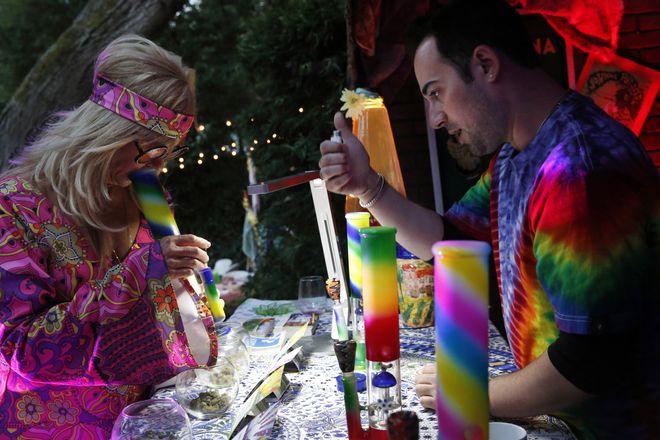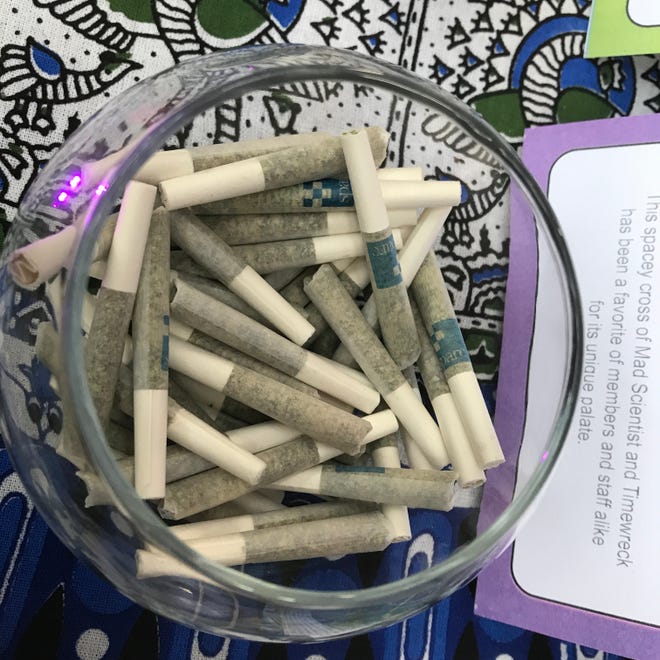Scenes from a posh private cannabis party

“It’s not very McKinsey-like!” said a 30-ish woman, who presumably worked at the international consulting firm, while glancing at marijuana and tall glass bongs at a backyard party in San Mateo, California, before quickly walking away.
Many of the 50 guests at philanthropist Crickette Brown Glad’s “Summer of Love” party on Aug. 19 were happy enough to dress in tie-dye clothing and dance to a live band playing songs by Cream, the Monkees and other ‘60s music. But they were skittish when it came to being quoted about their views on the “Cannabis Cafe” set up by SPARC, a San Francisco medical marijuana dispensary. (The city of San Mateo does not allow medical dispensaries.)
“I’ve never seen this before — I think it’s cool,” said a woman named Susan from Hillsborough, smelling the strains of dried bud in the same way people sniff and swirl at a wine tasting.
Indeed, despite the passage of Proposition 64 in November, which legalized recreational cannabis use for adults 21 and older, few — if any — event planners in the Bay Area have reported their clients asking for cannabis tasting bars. It was a first for Silicon Valley party planner Rick Herns, who has supplied giraffes, parrots and performance artists, as well as wine, whiskey and cigar tastings for his clients’ parties before — but never a bud bar, until now.
To make the party legal, he said, the host needed a medical marijuana recommendation (she already had one) and then had to gift — not sell — the cannabis to her guests. Adults 21 and over can legally share up to an ounce with other adults 21 and over. Legal sales are expected to begin in 2018, but it remains illegal to use cannabis on city streets, parks, or in any place the public gathers — like bars. Parties like this are virtually the only way for people to use cannabis in a group setting.
In effect, private is the new public.
Budtenders Harley Melson and Robbie Rainin explained that tetrahydrocannabinol (THC) is the chemical within cannabis that causes euphoria, while cannabidiol (CBD) is non-psychoactive and helps with inflammation and anxiety. Six strains, all grown by SPARC in controlled conditions, were on hand: “Reserve Zelda,” “Reserve Lavender,” “Reserve Sour Lime,” “Sour Banana Sherbet,” “Blue Dream” and “Dr. Who.” (No vaporizers were provided; they didn’t exist in 1967.)
“Did I do it right?” a woman asked, as she inhaled gently through a bong, a form of water pipe.
Rainin shook his head no, asking her to watch. “You have to suck the air hard enough,” he said, flicking the lighter’s flame into the bowl and inhaling deeply, “to make the water bubble.”
She tried again. This time, she exhaled a bit of smoke, and a few coughs, enough of a success to cause an onlooker to give her a high five, and shout, “You did it!”
The crowd skewed older — 50 and up — and was largely interested in which strains were good for insomnia. Cannabis comes in two types: sativa, which is stimulating; and indica, which yields indolence, relaxation and sleepiness. Indica ruled the evening.
Glad, the party host, has been using medical marijuana for two months to help with jaw pain from grinding her teeth at night. Botox injections to relax her jaw muscles only made her bite “feel like mush,” she said. She prefers two drops of a non-psychoactive CBD tincture under her tongue at night, which have alleviated the clenching that gave her a headache upon waking in the morning.
“It feels like we’re at the beginning of pain medication, but in a different way,” said Glad, who wanted to share the information with her friends by providing the bud bar. “It’s not that people are necessarily trying to get high. It’s to get relief from something. People are going to be happier and feel better physically and live a happier life.”
Guests appreciated the introduction in a safe environment — and scooped up tiny, pre-rolled joints with .2 grams of cannabis to try at home. But they still feared repercussions at work — or their children calling them hypocrites — if anyone outside the party learned they’d partaken of a puff, or even considered it.
“If you were asking me about a glass of wine, I wouldn’t hesitate to give you my name,” said a guest from Palo Alto. “There’s still a little stigma attached to it. It hasn’t quite joined the mainstream.”
Or has it?
“In the future,” said one man, eyeing the bowls of bud like a kid in a candy store, “you’re not gonna walk into a gastropub. There are gonna be grass-tro-pubs!”


